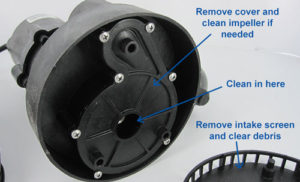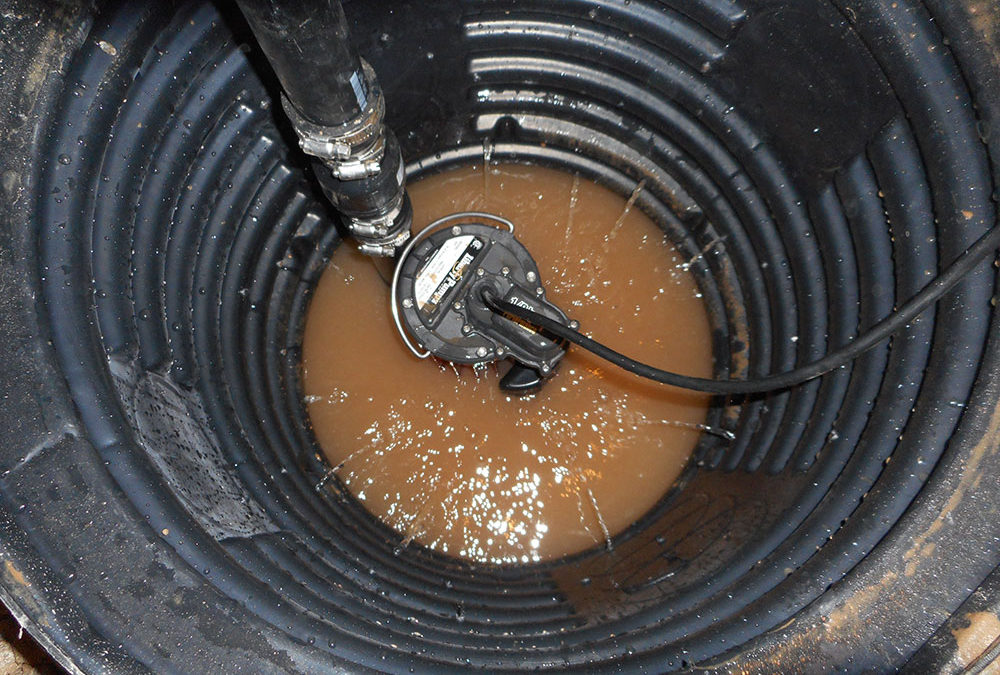In many parts of the country, incidents of basement water damage go up as spring gets going. The majority of these incidents are due to problems with a sump pump. As the ground thaws with the warmer temperatures, it becomes more and more saturated. Once spring rains hit, the rainwater cannot easily absorb into the ground. Basements, however, are absolutely ready to take on the water – they are basically just a big empty box waiting to be filled with water. Hence the sump pump. These pumps have an average lifespan of around 10 years, and it’s important to check them for proper operation annually, as they are one of the few things standing between you and a flooded basement.

Step 1: Inspect
Start by checking the sump pit for any debris that could interfere with your pump’s operation. If there is an “oil slick” on the surface of the water, the pump could be releasing coolant and may need replacement. Unplug the pump and take a look at the intake on the pump, and clean it out if necessary; do the same with the impeller, and the air bleed or weep hole.
Plug the pump back in. If you’re plugging into a Ground Fault Circuit Interrupter (GFCI) outlet, make sure that it’s fully operational. While newer GFCI outlets will alert you or stop working when their circuitry goes out, older outlets will not, and require testing using a specialized device – don’t just rely on the “test” button. Also, if you notice any frayed wires or exposed connections, have them repaired by a licensed electrician as soon as possible. Water and exposed electricity is never a safe combination.
Step 2: Test
Add a few gallons of water to your pit – enough to raise the float or reach the switch – to see if the unit is functioning properly. If the float rises too high without turning on, or the switch doesn’t activate the pump, unplug the unit and check again for debris in the unit and the pit. If the pump does operate correctly, turn your attention to the discharge pipe. If flow appears to be reduced, look for any blockages. You may need to disconnect the pipe from the pump and run high-pressure water, or even a snake, through it.
Step 3: Plan Ahead
Get a Backup Pump
Hopefully, you have a backup pump. If you don’t, it is strongly urged that you get one (especially in flood-prone areas) – storms are not the best time to bank on an uninterrupted power supply. Even if the power stays on, there is always the possibility that your pump just won’t be able to deal with the inundation of a, particularly powerful storm. Compared to the cost (monetary and otherwise) of repairing water damage, a backup pump is a serious bargain.
Inspect & Test Your Backup
Backup pumps are battery or water powered and need to be inspected along with the primary pump. For a water-powered pump, be sure that the supply valve is open before you start. With a battery-powered pump, start by making sure the water level in the battery is good: there should be a fill line, usually 1/2″ from the top of the case. Always be sure to follow manufacturer instructions.
As you did with the primary, you’ll want to disconnect the backup’s power and inspect the intake and impeller. Once these are all clear, reconnect the backup power supply and disconnect the primary pump. Fill the pit again and make sure the backup activates properly. Once that’s been verified, don’t forget to plug in the primary pump again.
(Note: Those who rely on a well for their water are advised to invest in battery-powered backup pumps only. Wells generally do not have enough water available to run a water-powered pump.)
Stay Informed
Like a backup pump, a high water alarm or flood prevention device is a very good idea if you don’t already have one. If you have a sump pump, you’re obviously concerned about flooding and water damage. It only makes sense to invest in these “add-ons” as well: if you’re looking to protect your home, using only one device to do it is risky, especially when that device is a piece of mechanical equipment. If you already have an alarm set up to alert you when the water level is too high, overflows, or when the pump malfunctions, test its operation by either raising the float arm to activate it or placing water on sensors.

